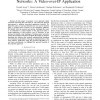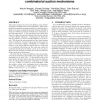550 search results - page 99 / 110 » A Design Process for Adaptive Behavior of Situated Agents |
SECON
2008
IEEE
14 years 1 months ago
2008
IEEE
—In this paper we present a new approach called cue-based networking that uses hints or cues about the physical environment to optimize networked application behavior. We define...
ATAL
2010
Springer
13 years 8 months ago
2010
Springer
This paper analyzes the worst-case efficiency ratio of falsename-proof combinatorial auction mechanisms. False-nameproofness generalizes strategy-proofness by assuming that a bidd...
CHI
2004
ACM
14 years 7 months ago
2004
ACM
We present a method for performing selection tasks based on continuous control of multiple, competing agents who try to determine the user's intentions from their control beh...
HRI
2007
ACM
13 years 11 months ago
2007
ACM
The goal of the RUBI project is to accelerate progress in the development of social robots by addressing the problem at multiple levels, including the development of new scientifi...
POPL
1999
ACM
13 years 11 months ago
1999
ACM
An ambient is a named cluster of processes and subambients, which moves as a group. We describe type systems able to guarantee that certain ambients will remain immobile, and that ...


